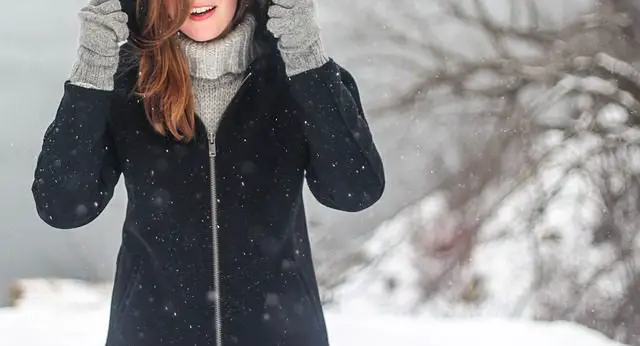
When winter rolls in, it’s tempting to stay inside where it’s warm. But just because it’s cold doesn’t mean you can’t enjoy the trails and parks, and all the winter activities too! With the proper clothing, you can stay warm outdoors in winter! This article covers how you can stay warm in cold weather, in other words, what to wear outdoors this winter! (Hint: Layers, layers, layers)
How to Stay Warm in Cold Weather
You don’t have to spend a ton on winter gear to stay warm outdoors in the winter. And you probably already have what you need to brave mild winter temperatures, like 30°F or above.
Yet, if you spend time outdoors in the winter, safety should be your priority. Cold temperatures can quickly lead to frostbite and hypothermia, which can be life-threatening. So, it’s best to prepare for inclement weather and extreme temperatures.
How to dress warm for cold weather
The key to staying warm outdoors in winter is to dress in layers. And the order of layers matters. When done right, they can keep you warm all day long! Another nice thing about layers is you won’t feel so bulky you can’t even move.
Base layer
The base layer wicks moisture away from your body. And most of us still sweat even when it’s cold outside, especially if we’re active. But moisture lowers your body temperature more quickly. So in freezing temps, staying dry can help prevent hypothermia.
A good base layer should fit close to the skin, be breathable, and pull sweat away from your skin. For example, some people use long underwear as a base layer. The primary prerequisite is that the material wicks moisture away from your skin. So, wool, polyester, nylon, or silk work pretty well. But avoid any material that soaks up moisture, like cotton, for instance.
Insulating layer
The middle layer keeps you warm and toasty by trapping your body heat. This layer is likely the bulkiest – fleece, wool, and insulated jackets work well here.
Fleece and wool are practical insulating layers since they keep you warm. But an outer shell is a must to keep the wind out and the heat in.
A down or synthetic insulated jacket may not need an outer shell (if it has water and wind protection).
Your activity level determines the best insulating layer. For example, fleece or wool are good options if you’re moving a lot since they’re more breathable. But if you’re sitting still outdoors in the cold, a puffy insulated jacket might be what you need.
Outer layer
The outer layer protects you from the elements. It should be wind and waterproof to keep you warm and dry. Shells are often thin and durable, repelling rain and snow and protecting you from the wind. Also, they should allow airflow so moisture can escape when you’re active (some have vents).
Some insulated jackets have an outer shell built in. In this case, you might be able to skip the outer layer. But, take your activity level and the weather into account. Skipping the outer layer in favor of an insulated jacket means you have one less layer to remove if you get hot.
Other essential winter clothing: Socks, shoes, gloves, scarves, and hats
Covering your extremities in cold temperatures keeps you safe and warm – your feet, hands, and head are the first things that will start to feel cold.
Socks
Feet are susceptible to frostbite in the winter, yet they’re challenging to keep warm. That’s why layering socks makes sense too.
Layer sock material as you would your clothing. Put a thin, snug moisture-wicking material as your base layer. Then add on an insulating layer, like wool or a synthetic blend. Avoid cotton at all costs.
Shoes/Boots
Fit and warmth are essential when it comes to winter shoes and boots. And they need to fit just right.
If your shoes are too tight, your toes will freeze faster. But if they’re too loose, they won’t keep your feet as warm, plus they’ll be uncomfortable. Keep in mind, you might have to adjust your shoe size to account for socks.
The type of winter shoes/boots depends on where and how you wear them. Waterproof material is a definite must! And extra insulation is good too. Other things to consider are height, traction, temperature rating, and weight.
Gloves/Mittens
Like other winter clothing, suitable material and a good fit are essential for gloves and mittens. Mittens generally keep fingers warmer. But gloves allow more movement.
If you’re in the snow, a waterproof outer material is a must, with an insulating layer underneath. For gloves, make sure they aren’t so snug that you can’t use your hands. You should be able to stretch out your fingers and still have a small amount of room at your fingertips.
Hat
Just like the rest of your body, you need to keep your head and ears warm and dry in the winter! Hats that fit close to your head trap heat.
Wool hats are a good option if you can tolerate wool. Other suitable materials are nylon, fleece, or fur, but avoid cotton (it soaks up the moisture!).
A scarf or neck gaiter
Believe it or not, you can lose a lot of heat from your neck, so scarves or neck warmers are essential. Also, you can pull a scarf up to help protect your face too.
A breathable, moisture-wicking material is, once again, a great option. If you don’t like scarves, consider a neck gaiter or buff (which are super versatile too!).
Can you stay warm in cold weather without a coat?
We recommend wearing layers or an insulated coat in the winter. Going without can lead to frostbite and hypothermia and can be life-threatening.
That said, if you are without a coat, there are some things you can do to try to stay warm.
- Wear layers of clothing. Even if you don’t have jackets, layer your clothing (like we described above). Material matters: wool, fleece, and nylon help trap your body heat. And try to wear layers that fit snug to keep in the heat.
- Cover your head, neck, ears, feet, and hands. Scarves, gloves, hats, and thick or layered socks are a necessity.
- Keep hand and foot warmers with you. Use Hot Hands or other hand/toe warmers to keep you from getting too cold.
- Keep moving around to stay warm, but guard against sweating.
- Drink hot beverages.
- In an emergency, garbage bags or similar materials can help protect you from the elements.


